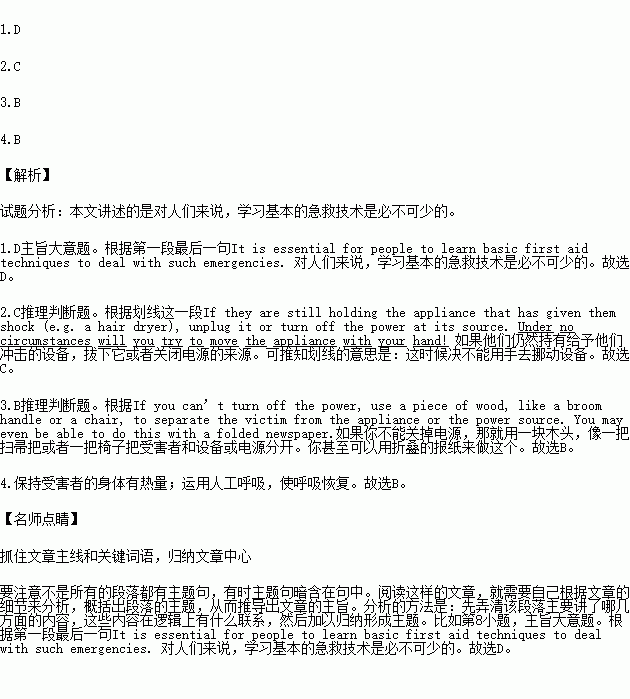题目内容
Government statistics recently showed that in the UK, more than 3,000 people a year experience electric shocks in their home. A smaller number of people are killed after contact with power lines outside the home. Electric shocks can cause a person’s heart or breathing to stop, can also cause burns and are potentially fatal. It is essential for people to learn basic first aid techniques to deal with such emergencies.
What to do?
If you are the first person to reach someone who has had an electric shock, don’t touch them!
If they are still holding the appliance that has given them shock (e.g. a hair dryer), unplug it or turn off the power at its source. Under no circumstances will you try to move the appliance with your hand!
If you can’t turn off the power, use a piece of wood, like a broom handle or a chair, to separate the victim from the appliance or the power source. You may even be able to do this with a folded newspaper.
The victim must remain lying down. If they are unconscious, victims should be placed on their side. But they should not be moved if there is a possibility of neck or spine injuries unless it is absolutely necessary.
It is essential to maintain the victim’s body heat, so make sure you cover him or her with a blanket before you do anything else. If the victim is not breathing, apply mouth-to-mouth resuscitation(恢复呼吸). Keep the victim’s head low until professional help arrives.
If the electric shock has been caused by an external power line, the dangers to the victim and to anybody providing first aid are much greater.
1.What kind of passage is it?
A. An advertisement. B. A horror story.
C. A news report. D. First aid emergency advice.
2.The underlined sentence, “Under no circumstances will you try to move the appliance with your hand!” implies that .
A. you should move the appliance that caused it
B. you should pick up the appliance and turn off the electricity
C. it is very dangerous to touch the appliance with your hands
D. it is unnecessary to unplug the appliance with your hands
3.If you can’t turn off the power, you cannot separate the victim from the appliance or the power source by using _________.
A. a folded newspaper B. a blanket
C. a broom handle D. a chair
4.When a person has got an electric shock, you should .
A. separate the victim from the appliance and let them sit up
B. keep the victim warm and help them breathe again
C. move the victim onto their side if they have got neck injuries
D. keep the victim’s head high until professional help arrives
根据句意从方框中选出合适的短语, 用其适当的形式完成句子。
think highly of, rely on, associate … with, break up, in charge of , come off , serve as, sort out, |
1.In addition to _________________ the e-mails, the secretary was also asked to finish writing a speech for the manager.
2. Ever since her parents ___________________, Jane has become extremely depressed and upset.
3.I don’t think Jack is a man to ________________when we are in trouble, for he cares nobody but himself.
4.A young man entered the office, wanting to see the manager _________________ sales department.
5.Lang Ya Bang was a big TV hit last year, which was ____________________ by both audience and critics.
6.The sofa can _________________ a temporary bed when we need  to put up a guest for the night at home.
to put up a guest for the night at home.
7.A healthy life is frequently thought to __________________ the homegrown food.
8.They had wanted to give her a surprise on her birthday but the plan didn’t _____________.

